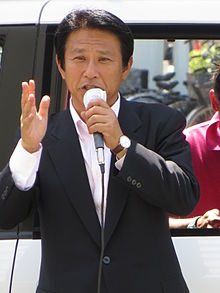Shinji Tarutoko
Shinji Tarutoko | |
|---|---|
樽床 伸二 | |
 Official portrait, 2012 | |
| Minister for Internal Affairs and Communications | |
| In office 1 October 2012 – 26 December 2012 | |
| Prime Minister | Yoshihiko Noda |
| Preceded by | Tatsuo Kawabata |
| Succeeded by | Yoshitaka Shindō |
| Member of the House of Representatives | |
| In office 22 October 2017 – 28 January 2019 | |
| Preceded by | Multi-member district |
| Succeeded by | Sumio Mabuchi |
| Constituency | Kinki PR |
| In office 31 August 2009 – 16 November 2012 | |
| Preceded by | Tomokatsu Kitagawa |
| Succeeded by | Tomokatsu Kitagawa |
| Constituency | Osaka 12th |
| In office 19 July 1993 – 8 August 2005 | |
| Preceded by | Multi-member district |
| Succeeded by | Tomokatsu Kitagawa |
| Constituency | Osaka 7th (1993–1996) Osaka 12th (1996–2005) |
| Personal details | |
| Born | 6 August 1959 Mitoya, Shimane, Japan |
| Political party | Independent (1990–1992; 2016–2017; 2018–present) |
| Other political affiliations | |
| Alma mater | Osaka University |
| Website | Official website |
Shinji Tarutoko (樽床 伸二, Tarutoko Shinji, born 6 August 1959) is a Japanese politician and former member of the House of Representatives.
Early life and education
[edit]Tarutoko was born in Shimane Prefecture on 6 August 1959. He studied at the Matsushita Institute of Government and Management.[1]
Career
[edit]
Tarutoko was first elected to the House of Representatives in the 1993 election as a member of the defunct Japan New Party.[1] Then he joined the Democratic Party of Japan in 1998.[1]
In June 2010, he declared his intention to run against Naoto Kan for the leadership of the Democratic Party of Japan; had he won, he would have become the next Prime Minister of Japan.[2] However, he was defeated on a 291–129 vote.[3] He was appointed Minister of Internal Affairs and Communications by Prime Minister Yoshihiko Noda on 1 October 2012.[1]
He lost his seat in the 16 December 2012 general election to Tomokatsu Kitagawa, who he had defeated in the 2009 election.[4] Tarutoko challenged Kitagawa again in 2014, but failed. He became the top candidate on Kibō no Tō's Kinki proportional representation list in 2017 and was elected back to the House.[5]
Tarutoko resigned his seat on 28 January 2019 to contest the Osaka 12th district by-election, which was called after Kitagawa's death.[6]
References
[edit]- ^ a b c d "Profiles of ten new ministers in Noda's Reshuffled Cabinet". The Yomiuri Shimbun. 3 October 2012. Retrieved 9 October 2012.
- ^ "Politics". NHK. Archived from the original on 6 October 2012. Retrieved 9 October 2012.
- ^ "Naoto Kan Wins Leadership Ballot, Becomes Favorite for Prime Minister"[1]
- ^ Japan Times Nothing left for the election-gutted DPJ to do but rebuild 18 December 2012
- ^ "比例区開票速報:近畿ブロック(定数28)" (in Japanese). Asahi Shimbun. Retrieved 22 February 2019.
- ^ "比例東海・近畿 青山氏と馬淵氏、繰り上げ当選に)" (in Japanese). Mainichi Shimbun. 5 February 2019. Retrieved 22 February 2019.
- 1959 births
- Democratic Party of Japan politicians
- Living people
- Osaka University alumni
- Politicians from Shimane Prefecture
- Ministers of internal affairs of Japan
- Members of the House of Representatives (Japan) 2003–2005
- Members of the House of Representatives (Japan) 2009–2012
- Members of the House of Representatives (Japan) 2017–2021
- Japanese politician, 1950s birth stubs
